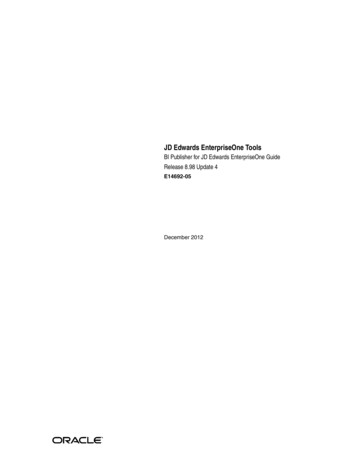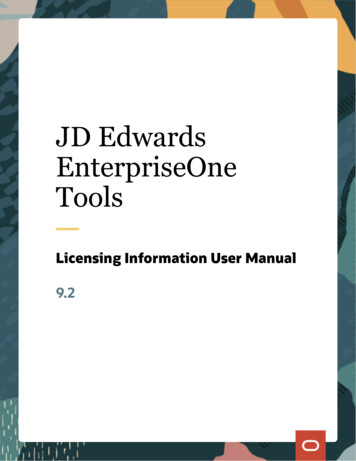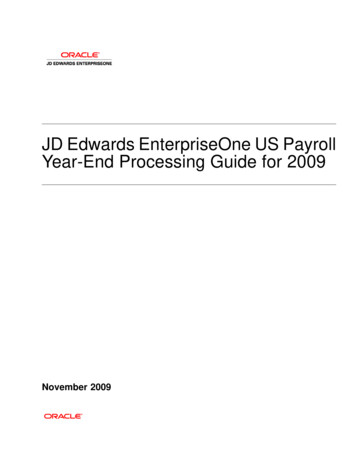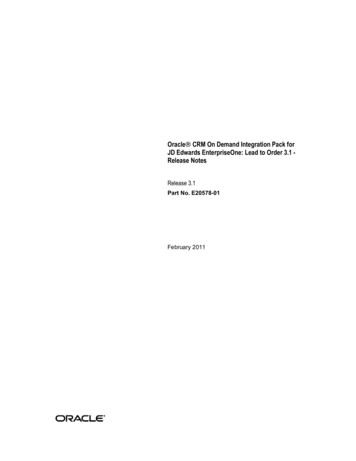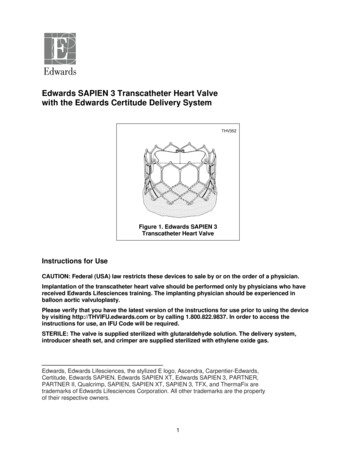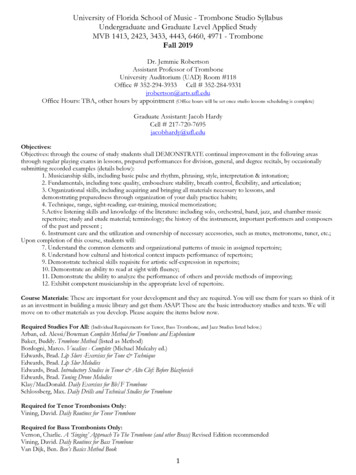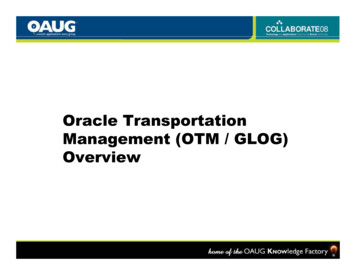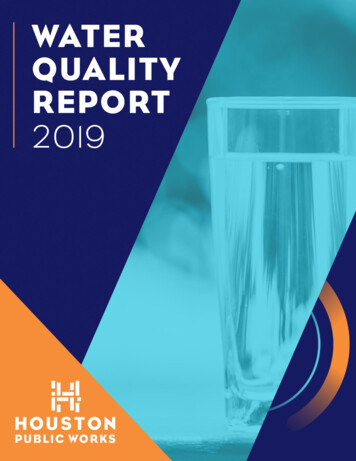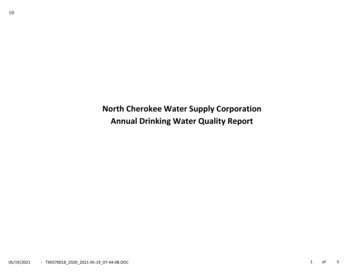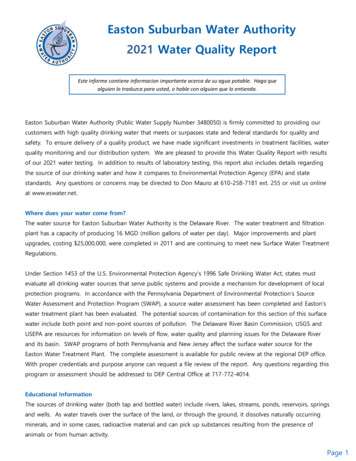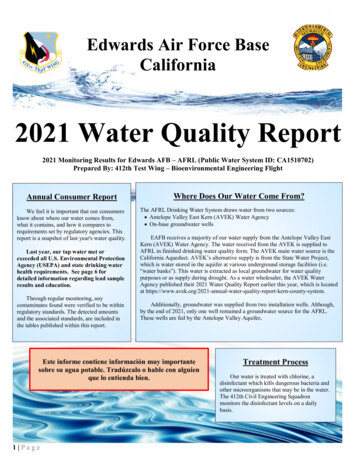
Transcription
Edwards Air Force BaseCalifornia2021 Water Quality Report2021 Monitoring Results for Edwards AFB – AFRL (Public Water System ID: CA1510702)Prepared By: 412th Test Wing – Bioenvironmental Engineering FlightAnnual Consumer ReportWe feel it is important that our consumersknow about where our water comes from,what it contains, and how it compares torequirements set by regulatory agencies. Thisreport is a snapshot of last year's water quality.Last year, our tap water met orexceeded all U.S. Environmental ProtectionAgency (USEPA) and state drinking waterhealth requirements. See page 6 fordetailed information regarding lead sampleresults and education.Through regular monitoring, anycontaminates found were verified to be withinregulatory standards. The detected amountsand the associated standards, are included inthe tables published within this report.Where Does Our Water Come From?The AFRL Drinking Water System draws water from two sources: Antelope Valley East Kern (AVEK) Water Agency On-base groundwater wellsEAFB receives a majority of our water supply from the Antelope Valley EastKern (AVEK) Water Agency. The water received from the AVEK is supplied toAFRL in finished drinking water quality form. The AVEK main water source is theCalifornia Aqueduct. AVEK’s alternative supply is from the State Water Project,which is water stored in the aquifer at various underground storage facilities (i.e.“water banks”). This water is extracted as local groundwater for water qualitypurposes or as supply during drought. As a water wholesaler, the AVEK WaterAgency published their 2021 Water Quality Report earlier this year, which is locatedat ort-kern-county-system.Additionally, groundwater was supplied from two installation wells. Although,by the end of 2021, only one well remained a groundwater source for the AFRL.These wells are fed by the Antelope Valley Aquifer.Este informe contiene información muy importantesobre su agua potable. Tradúzcalo o hable con alguienque lo entienda bien.1 PageTreatment ProcessOur water is treated with chlorine, adisinfectant which kills dangerous bacteria andother microorganisms that may be in the water.The 412th Civil Engineering Squadronmonitors the disinfectant levels on a dailybasis.
What Is In Drinking Water?Drinking water, including bottled water, may reasonably beexpected to contain at least small amounts of some contaminants.The presence of contaminants does not necessarily indicate thatthe water poses a health risk. More information about contaminantsand potential health effects can be obtained by calling theEnvironmental Protection Agency's (EPA) Safe Drinking WaterHotline (1-800-426-4791).The sources of drinking water (both tap water and bottled water)include rivers, lakes, streams, ponds, reservoirs, springs, and wells.As water travels over the surface of the land or through the ground, itdissolves naturally-occurring minerals and, in some cases,radioactive material, and can pick up substances resulting from thepresence of animals or from human activity.Contaminants that may be present in source water include:Pictured above: A technician from the 412th Operational Medical ReadinessSquadron, Bioenvironmental Engineering Flight conducting routine watertesting at locations spanning the water distribution system. Water samples arecollected, tested by a certified laboratory, and results are submitted to theState Water Resources Control Board to demonstrate compliance with allrequirements and regulations.Source Water AssessmentThe 412th Civil Engineering (CE) Squadron completed ourSource Water Assessment on 18 June 2003 and it is on file in theCE Water & Gas office (661-277-5000). This assessment looks atpossible contamination sources that may affect the base watersupply. Possible contaminating activities for the wells surveyed inthis assessment include nearby abandoned wells, storm drainagedischarge, above ground water storage tanks, and nearby roads.The health risks from these activities are diminished throughweekly monitoring of the potable water system.EAFB is aware that many buildings at AFRL use bottledwater. EAFB is not responsible for sampling or for reporting onbottled water. Water quality reports for your bottled water may beobtained by contacting your building’s bottled water vendor. Microbial contaminants, such as viruses and bacteria, that maycome from sewage treatment plants, septic systems, agriculturallivestock operations, and wildlife. Inorganic contaminants, such as salts and metals, that can benaturally-occurring or result from urban stormwater runoff, industrialor domestic wastewater discharges, oil and gas production, mining,or farming. Pesticides and herbicides, that may come from a variety of sourcessuch as agriculture, urban stormwater runoff, and residential uses. Organic chemical contaminants, including synthetic and volatileorganic chemicals, that are byproducts of industrial processes andpetroleum production, and can also come from gas stations, urbanstormwater runoff, agricultural application, and septic systems. Radioactive contaminants, that can be naturally-occurring or be theresult of oil and gas production and mining activities.In order to ensure that tap water is safe to drink, the U.S.Environmental Protection Agency (USEPA) and the State WaterResources Control Board (State Board) prescribe regulations thatlimit the amount of certain contaminants in water provided by publicwater systems. The State Board regulations also establish limits forcontaminants in bottled water that provide the same protection forpublic health.Consumption Note for Susceptible IndividualsSome people may be more vulnerable to contaminants in drinking water than the general population. Immuno-compromised personssuch as persons with cancer undergoing chemotherapy, persons who have undergone organ transplants, people with HIV/AIDS or otherimmune system disorders, some elderly, and infants can be particularly at risk from infections. These people should seek advice aboutdrinking water from their health care providers. USEPA/Centers for Disease Control (CDC) guidelines on appropriate means to lessenthe risk of infection by Cryptosporidium and other microbial contaminants are available from the Safe Drinking Water Hotline (1-800426-4791).2 Page
Water Quality Data TableAll sources of drinking water contain some naturally occurring contaminants. At low levels, these substances are generally notharmful in our drinking water. Removing all contaminants would be extremely expensive, and in most cases, would not provide increasedprotection of public health. Additionally, some naturally occurring minerals provide benefits by improving the taste of drinking water andproviding nutritional value at low levels.In order to ensure that tap water is safe to drink, the USEPA prescribes regulations which limit the amount of contaminants in waterprovided by public water systems. The tables on the following pages list all of the drinking water contaminants that were detected duringthe 2021 calendar year of this report. Many more contaminants were tested than listed on the following table; only those substances listedbelow were detected in our water. The USEPA and state allow us to monitor for some contaminants less than once per year because theconcentrations of these contaminants do not change frequently, or because the system is not considered vulnerable to this type ofcontamination. As such, some of our data, though representative, is more than one year old.In these tables you may find terms and abbreviations that might not be familiar to you. To help you better understand these terms, wehave provided the definitions below.TermALImportant Terms UsedDefinitionAction Level: The concentration of a contaminant which, if exceeded, triggers treatment or other requirements which awater system must follow.LRAALocal Running Annual Average: Annual running average at a single sampling site.MCLMaximum Contaminant Level: The highest level of a contaminant that is allowed in drinking water. Primary MCLs are setas close to the PHGs (or MCLGs) as is economically and technologically feasible. Secondary MCLs are set to protect theodor, taste, and appearance of drinking water.MCLGMFLmg/LMRDLMRDLGMaximum Contaminant Level Goal: The level of a contaminant in drinking water below which there is no known orexpected risk to health. MCLGs are set by the U.S. Environmental Protection Agency.MFL: million fibers per liter, used to measure asbestos concentrationMg/L: Milligrams per Liter (ppm)Maximum residual disinfectant level. The highest level of a disinfectant allowed in drinking water. There is convincingevidence that addition of a disinfectant is necessary for control of microbial contaminants.Maximum residual disinfection level goal. The level of a drinking water disinfectant below which there is no known orexpected risk to health. MRDLGs do not reflect the benefits of the use of disinfectants to control microbial contaminants.N/ANDpCi/LNot ApplicableNot DetectedpCi/L: picocuries per liter (a measure of radioactivity)PDWSPrimary Drinking Water Standards: MCLs and MRDLs for contaminants that affect health along with their monitoring andreporting requirements, and water treatment requirements.PHGPublic Health Goal: The level of a contaminant in drinking water below which there is no known or expected risk to health.PHGs are set by the California Environmental Protection Agency.ppbppmppb: parts per billion, or micrograms per liter (µg/L)ppm: parts per million, or milligrams per liter (mg/L)SDWSµg/L3 PageSecondary Drinking Water Standards: MCLs for contaminants that affect taste, odor, or appearance of the drinking water.Contaminants with SDWSs do not affect the health at the MCL levels.Micrograms per Liter (ppb)
Wate r Q uality Data TableContaminantMCLPHGAVEKPlantAve rage 1AVEK We ll AFRL We llAve rage 2Ave rageAFRL We ll RangeSampleDateViolationMajor Source s in Drinking Wate rInorganic Contaminants (PDWS)Aluminum (µg/L)100060053NDNDND2021NoErosion of natural deposits; residue from some surface water treatment processesArsenic3 (µg/L)100.00444.99.86.6-152021NoBarium (µ/L)1000200059NDNDND2021NoT otal Chromium(µg/L)10MCLG 1007.1NDNDND2021NoDischarge from steel and pulp mills and chrome plating; erosion of natural depositsHexavalentChromium 4 (ppb)100.025.82.95.675.38 – 5.952014NoDischarge from electroplating factories, leather tanneries, wood preservation,Fluoride (mg/L)210.270.150.30.30 – 0.332021NoNitrate (as N)(mg/L)10102.62.60.380.382021NoErosion of natural deposits; runoff from orchards; glass and electronics productionwastesDischarges of oil drilling wastes and from metal refineries; erosion of naturaldepositschemical synthesis, refractory production, and textile manufacturing facilities;Erosion of natural deposits; water additive that promotes strong teeth; dischargefrom fertilizer and aluminum factoriesRunoff and leaching from fertilizer use; leaching from septic tanks and sewage;erosion of natural depositsSampling Re sults Showing De te ction of Le ad and Coppe rLead5 (µg/L)Copper 5 (mg/L)AL 90% ofbldgs. 15AL 90% ofbldgs. 1.30.2NDNDND0.3NDND0.0110 sites sampled; 0 sitesover AL10 sites sampled; 0 sitesover AL2021No2021NoInternal corrosion of household water plumbing systems; discharges from industrialmanufacturers; erosion of natural depositsInternal corrosion of household plumbing systems; erosion of natural deposits;leaching from wood preservativesRadioactive Contaminants (PDWS)Gross Alpha(pCi/L)15MCLG 0NA5.34.874.15 - 5.582021NoErosion of natural depositsUranium (pCi/L)200.43NANA1.321 – 1.632021NoErosion of natural depositsDisinfe ctants & Disinfe ction By Products (PDWS)T otalT rihalomethanes(µg/L)LRAA:80N/A20NA20.6#9.9 - 382021NoByproduct of drinking water disinfectionHaloacetic Acids(µg/L)LRAA:60N/A2.7NA2.9#2 - 3.82021NoByproduct of drinking water disinfection1.2.3.4.5.AVEK Plant Average data obtained from previous Kern County Annual Water Quality ReportsAVEK Wells Average data obtained from 2021 Annual Water Quality Report – Kern CountyIn accordance with monitoring with the State Water Resources Control Board, drinking water is in compliance for arsenic because the running average is below the MCL.There is currently no MCL for hexavalent chromium. The previous MCL of 0.010 mg/L (10 ppb) was withdrawn on September 11, 2017Lead and Copper is regulated by ensuring the 90th percentile of sample result in under the AL. In this case, our results were ND for Lead and 0.097 for Copper. ampling isconducted every 3 years. In 2018, two buildings detected lead and increased compliance monitoring was conducted in accordance with an approved plan from the Sate WaterResources Control Board. The most recent samples were collected between July and September 2021 as part of this monitoring plan.# This value represents the location with the highest average of TTHM or HAA5 of all the sampling locations.4 Page
ContaminantMCL6PHGTotal ColiformBacteria0 positivemonthlysample0Calcium (mg/L)N/AN/AChloride (mg/L)500N/AColor (units)15N/AHardness (mg/L)N/AN/AIron erageAFRLWellAverageAFRL WellRangeSampleDateViolationMajor Sources in Drinking WaterMicrobiological Contaminants (PDWS)NANDNDND2021NoNaturally present in the environmentSecondary Standard Contaminants (SDWS)587522.9517.6 - 28.32015NoLeaching from natural deposits55709.316.32-12.32015NoRunoff/leaching from natural deposits; seawater influence 5 52ND – 42015NoNaturally-occurring organic materials1802207858-982015NoThe sum of polyvalent cations present in the water, generally naturally occurring magnesium andcalciumN/ANDND0.2ND –0.4172015NoLeaching from natural deposits; industrial wastes0.05N/A9.18.50.001ND – 0.0022015NoLeaching from natural depositsSodium (mg/L)N/AN/A434358.850.4-67.22015NoLeaching from natural 6.5394-3992015NoSubstances that form ions when in water; seawater influenceSulfate g from natural deposits; industrial wastesTotal DissolvedSolids ng from natural depositsTurbidity (units)5N/A0.050.050.5730.205-0.9412015NoSoil runoffZinc (mg/L)5N/A0.52NDNDND2015NoRunoff/leaching from natural deposits; industrial wastes6.7.Secondary MCLs do not have PHGs or MCLGs because secondary MCLs are set to protect the aesthetics of water and PHGs and MCLGs are based on health concerns.The elevated measurement for iron above the MCL is based on one sample, at one well. Finished water is a mixture of water from all AFRL wells; the “AFRL Well Average”column is most representative for consumers.Additional Information for Water Quality in Low-Use Buildings due to COVID-19Please view the following links for information on how to ensure good water quality in buildings that may have a lack of usage due to the COVID-19 Pandemic. 412th CivilEngineering ensures the distribution system of EAFB is flushed and pulling fresh water.5 Page
Additional Information Regarding LeadIf present, elevated levels of lead can cause serious healthproblems, especially for pregnant women and young children. Lead indrinking water is primarily from materials and components associatedwith service lines and home plumbing. 412th BioenvironmentalEngineering Flight and 412th Civil Engineering Squadron areresponsible for providing high quality drinking water, but cannot controlthe variety of materials used in plumbing components. When yourwater has been sitting for several hours, you can minimize the potentialfor lead exposure by flushing your tap for 30 seconds to 2 minutesbefore using water for drinking or cooking. If you do so, you may wishto collect the flushed water and reuse it for another beneficial purpose,such as watering plants. If you are concerned about lead in your water,you may wish to have your water tested. Information on lead indrinking water, testing methods, and steps you can take to minimizeexposure is available from the Safe Drinking Water Hotline (800-4264791) or at http://www.epa.gov/lead.Infants and young children are typically more vulnerable to lead indrinking water than the general population. It is possible that lead levelsat your home may be higher than at other homes in the community as aresult of materials used in your home’s plumbing. If you are concernedabout elevated lead levels in your home’s water, you may wish to haveyour water tested and/or flush your tap for 30 seconds to 2 minutesbefore using tap water. Additional information is available from theU.S. EPA Safe Drinking Water Hotline (1-800-426-4791).Additional InformationRegarding ArsenicWhile your drinking water meets federal and state standard forarsenic, it does contain low levels of arsenic. The arsenic standardbalances the current understanding of arsenic's possible health effectsagainst the costs of removing arsenic from drinking water. The U.S.Environmental Protection Agency continues to research the healtheffects of low levels of arsenic which is a mineral known to causecancer in humans at high concentrations and is linked to other healtheffects such as skin damage and circulatory problems.6 PageAdditional InformationRegarding FluorideThe AFRL water systems contain naturally occurringfluoride. AFRL does not add additional fluoride to the watersystem due to State requirements and the scope/size of theEAFB water distribution system. The natural level offluoride present in the water system is below the maximumcontamination limit (MCL) of 2.0 parts per million (ppm).In 2015, the U.S. Department of Health and HumanServices released a Public Health Service recommendation of0.7 ppm as the optimal fluoride level in drinking water toprevent tooth decay. Your local dentist or pediatrician canprescribe daily fluoride brushing, tablets, or drops for youand your children to ensure you receive enough fluoride.Tips for Protecting Your Water Eliminate excess use of lawn and garden fertilizers andpesticides – they contain hazardous chemicals that canreach your drinking water source. Pick up after your pets. Dispose of chemicals properly; take used motor oil to arecycling center.For more information regarding this report, pleasecontact either: 412th Operational Medical Readiness Squadron –Bioenvironmental Engineering Flight(661-277-3272) 412th Test Wing – Public Affairs(661-277-1454)
balances the current understanding of arsenic's possible health effects against the costs of removing arsenic from drinking water. The U.S. Environmental Protection Agency continues to research the health cancer in humans at high concentrations and is linked to other health effects such as skin damage and circulatory problems.
